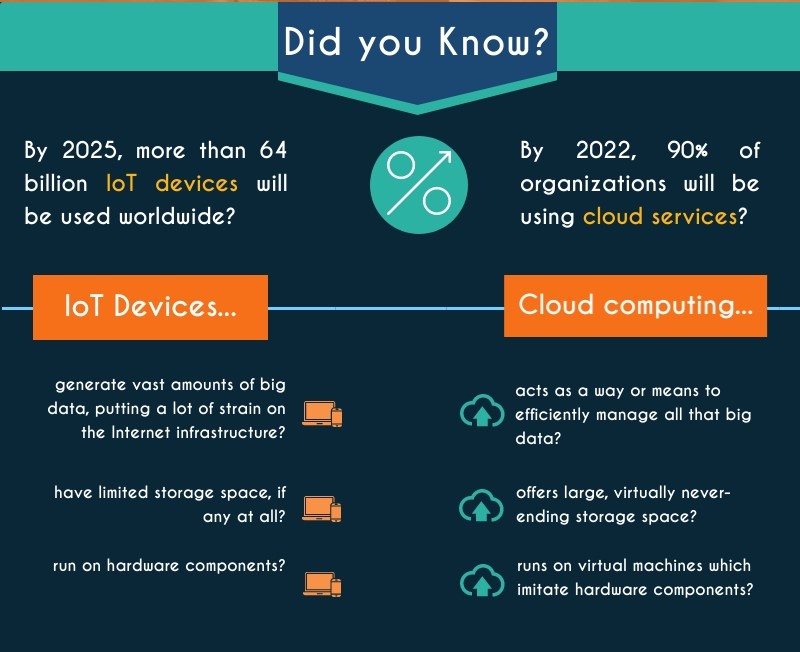As technology continues to advance, it’s becoming more and more important for businesses and individuals alike to understand the role of cloud computing in IoT devices. The question is: how does cloud computing help IoT devices? By understanding how these two technologies interact with each other, organizations can leverage their data efficiently while keeping costs low.
In this article, we’ll explore what cloud computing is, what IoT devices are, how they benefit from one another when combined as well as some challenges that may arise when integrating them both. So let’s answer together: how does cloud computing help IoT devices?
Table of Contents
What is Cloud Computing?
Before we answer “how does cloud Cloud computing help IoT devices,” let’s take a look at how cloud computing works.
Cloud computing is a type of technology that allows users to access data, applications, and services over the internet. It is a way for organizations to store and process their data in remote servers instead of using local hardware or on-premise systems. This makes it easier for businesses to scale up quickly without having to invest in additional infrastructure or personnel.
Definition of Cloud Computing
Cloud computing is defined as the delivery of computing services such as storage, networking, analytics, software development tools, databases, and more over the Internet (“the cloud”). These services are hosted by third-party providers who manage them on behalf of customers through a pay-as-you-go model.
Companies can use these services either individually or together depending on their needs. For example, an online retailer might use cloud storage to store customer orders while also using analytics tools to gain insights into consumer behavior patterns.
Benefits of Cloud Computing
The main benefit of cloud computing is cost savings since companies no longer need to purchase expensive hardware or hire specialized IT staff members just for managing it all. Additionally, with cloud computing companies can easily scale up resources when needed without having any downtime due to maintenance windows or other issues associated with traditional systems.
Finally, many cloud service providers offer high levels of security which helps protect sensitive company information from cyber threats like malware and ransomware attacks.
Types Of Cloud Computing Services
There are three primary types of cloud platforms available today: Infrastructure as a Service (IaaS), Platform as a Service (PaaS), and Software as a Service (SaaS).
IaaS provides virtualized compute resources such as servers and storage space along with network connectivity, allowing customers to build out their custom environment according to their specific requirements.
PaaS offers preconfigured environments where developers can deploy web applications quickly.
Finally, SaaS provides readymade solutions such as email hosting platforms that allow users access via the internet without needing any special software installed locally on their machines.
Cloud computing is a powerful technology that can provide many benefits to organizations, including improved scalability and flexibility. By leveraging the power of cloud technology, IoT devices can become more efficient and effective in managing data collection and analysis.
What Are IoT Devices?
How does cloud computing help IoT devices? To answer this better, let’s look at what IoT devices are.
IoT devices, or Internet of Things devices, are physical objects that have been connected to the internet and can collect and exchange data. They are used in a variety of applications such as home automation, smart cities, healthcare monitoring, industrial automation, and more.
IoT devices allow for remote control and monitoring of physical objects from anywhere in the world.
Definition of IoT Devices
An IoT device is any type of electronic device that has been connected to the internet which allows it to collect data from its environment and send this information back over the network. These devices range from simple sensors that measure temperature or light levels to complex systems like autonomous vehicles or robots.
Examples of IoT Devices
Examples of IoT devices include:
- Smart thermostats such as Nest Learning Thermostat can be controlled remotely through an app on a phone.
- Fitness trackers like Fitbit measure activity levels.
- Security cameras with facial recognition capabilities.
- Voice-activated speakers like Amazon Echo.
- Self-driving cars and drones for delivery services.
- Medical implants such as pacemakers monitor heart rate and alert doctors if something is wrong.
- Agricultural equipment including soil moisture sensors to gauge water content in crops so farmers know when they need irrigation.
The components necessary for a successful implementation of an IoT system include hardware (sensors/actuators), software (operating systems/applications), communication networks (WiFi/Bluetooth), and cloud computing infrastructure (data storage/processing).
The hardware collects data from its environment while the software processes this information into useful insights. Communication networks enable these two components to communicate with each other, while cloud computing provides a secure platform where all collected data can be stored securely without taking up too much space on local servers or computers.
IoT devices are becoming increasingly important in the modern world, and cloud computing provides several solutions to help them function optimally.
How Does Cloud Computing Help IoT Devices?
Cloud computing is an invaluable tool for businesses that are looking to leverage the power of IoT devices. Cloud computing provides a variety of solutions for data storage, management, security, and scalability that can help make the most out of IoT devices.
But how does cloud computing help IoT devices? Here are some of the ways.
Data Storage and Management Solutions for IoT Devices
Cloud-based solutions provide efficient ways to store large amounts of data generated by connected devices. This allows businesses to easily access this data in real-time from anywhere with an internet connection.
Additionally, cloud-based analytics tools allow companies to analyze their collected data quickly and accurately without having to invest in expensive hardware or software solutions.
Security Solutions for IoT Devices
With cloud computing, businesses can take advantage of advanced security features such as authentication protocols and encryption methods which protect sensitive information stored on connected devices from unauthorized access or manipulation.
Cloud-based monitoring systems can be used to detect any suspicious activity related to connected devices so that appropriate action can be taken immediately if needed.

(Source)
Scalability
One major benefit of using cloud computing is its ability to scale up or down depending on the needs of a business’s networked environment at any given time. This makes it easier for organizations to add more resources when needed without having to purchase additional hardware or software licenses upfront, thus saving them both money and time in the long run.
Cloud computing offers a wide range of solutions for IoT devices, from data storage and management to security and scalability.
Challenges with Integrating Cloud Computing and IoT Devices
Now that we have answered “how does cloud computing help IoT devices,” let’s look at some of the challenges of integrating the two technologies.
Connectivity Issues
One of the biggest challenges with integrating cloud computing and IoT devices is ensuring that they can communicate effectively. This requires a reliable connection between the two technologies, which can be difficult to achieve due to various factors such as distance, bandwidth availability, and network latency.
For example, if an IoT device is located in a remote area with limited access to high-speed internet or cellular networks, it may not be able to connect reliably with a cloud platform for data processing and storage.
Data Privacy and Security Concerns
Another challenge is protecting sensitive data from unauthorized access or misuse. Since both technologies involve transmitting large amounts of data over public networks, there is always a risk of malicious actors intercepting this information or using it for nefarious purposes.
To mitigate these risks, organizations must implement strong security measures such as encryption protocols and authentication systems on their connected devices as well as their cloud platforms.
Overall, integrating cloud computing and IoT devices can be a difficult process due to connectivity issues, data privacy, and security concerns, as well as cost considerations. However, with the right strategies in place, these challenges can be managed.
Conclusion
How does cloud computing help IoT devices? Cloud computing can be a great asset to IoT applications.
It helps them become more efficient and reliable by providing access to data storage, analytics capabilities, and machine learning tools. Cloud computing also makes it easier for businesses to manage their IoT networks since they don’t have to worry about the hardware or software associated with running the system.
However, some challenges come with integrating cloud computing and IoT devices such as security concerns and compatibility issues.
Cloud computing is becoming an increasingly important technology for the Internet of Things (IoT). It provides a secure platform to store and process data while enabling IoT devices to communicate with each other in real-time. By leveraging cloud services, organizations can unlock new capabilities and opportunities that will help them better manage their resources and make decisions faster than ever before.





